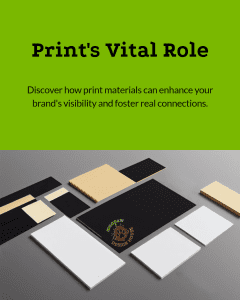In a world where digital marketing often steals the spotlight, printed business materials still hold their ground as powerful marketing tools. There’s something about the feel of a tangible marketing tool that resonates with people in a way digital just can’t match. Have you ever noticed how a well-designed business card or a striking brochure can leave a lasting impression? These printed pieces aren’t just old-school; they’re an important part of integrating print into your marketing mix. Let’s chat about how embracing the importance of print can boost your brand visibility and connect you with your ideal customers in a meaningful way. For more insights on essential printed marketing materials for your business, check out this comprehensive guide.
Importance of Print in Marketing
Print marketing continues to play a crucial role in today’s digital-dominated landscape. Let’s explore why tangible materials still pack a punch and how they can help your business stand out.
The Tangible Advantage
In a world of screens and clicks, there’s something special about holding a physical marketing piece in your hands. It’s not just about nostalgia; it’s about making a real connection.
Print materials engage multiple senses. When you hand someone a business card or brochure, they can feel the texture, see the colors, and even smell the ink. This multi-sensory experience creates a stronger memory than a fleeting digital ad.
People also tend to trust print more than digital content. A study by MarketingSherpa found that 82% of consumers trust print ads when making a purchase decision, compared to just 61% for search engine ads.
Lastly, print materials have staying power. A well-designed flyer might stay on someone’s desk for weeks, serving as a constant reminder of your brand.
Standing Out from Digital Clutter
In the sea of digital noise, print materials can be a breath of fresh air. They offer a break from the constant barrage of online ads and notifications.
Print allows for creativity in design and format. You can play with paper types, finishes, and unique shapes to create something truly eye-catching. This level of customization is harder to achieve in the digital realm.
Moreover, print materials can reach audiences who aren’t always online. Think about local community boards, direct mail campaigns, or in-store displays. These touchpoints can be valuable for reaching certain demographics or complementing your digital efforts.
Essential Printed Business Materials
Now that we’ve covered why print matters, let’s look at some key materials that can boost your marketing efforts. These tried-and-true formats continue to deliver results for businesses of all sizes.
Business Cards: Making Connections
Business cards remain a staple in professional networking. They’re often the first physical representation of your brand that a potential client or partner encounters.
A well-designed business card does more than just share contact info. It can convey your brand’s personality, showcase your creativity, and leave a lasting impression. Think about using unique materials or finishes to make your card stand out.
Remember, your business card is a mini-billboard for your brand. Make sure it aligns with your overall brand identity and includes all essential information. For inspiration, check out these innovative business card designs that push the boundaries of traditional formats.
Brochures and Flyers: Inform and Engage
Brochures and flyers are versatile tools for sharing detailed information about your products or services. They allow you to tell your brand story in a compact, visually appealing format.
When designing brochures, focus on clear, concise messaging. Use high-quality images and infographics to break up text and make information easily digestible. Consider using different folds or sizes to create interest and stand out from the crowd.
Flyers, on the other hand, are great for promoting specific events or offers. They should be eye-catching and to the point, with a clear call to action. Don’t forget to include your contact information and any relevant QR codes or website links to bridge the gap between print and digital.
Integrating Print into Your Strategy
Print shouldn’t exist in a vacuum. The key is to integrate it seamlessly with your digital marketing efforts for a cohesive, multi-channel approach.
Boosting Brand Visibility
Print materials can significantly enhance your brand visibility when used strategically. They provide tangible touchpoints that reinforce your digital presence.
Consider using print ads in local publications to drive traffic to your website or social media channels. You can include QR codes on printed materials that lead to special landing pages or exclusive online content.
Don’t forget about branded merchandise. Items like pens, notebooks, custom tees, or tote bags with your logo serve as walking advertisements. They keep your brand visible in everyday settings, extending your reach beyond traditional marketing channels.
Creating Meaningful Connections
Print materials offer unique opportunities to create personal connections with your audience. They can add a human touch to your marketing efforts that’s sometimes lost in digital communications.
Handwritten notes or personalized direct mail can make customers feel valued. These small gestures can go a long way in building loyalty and word-of-mouth referrals.
Consider creating limited edition print pieces for special customers or events. This exclusivity can make recipients feel special and strengthen their connection to your brand.


